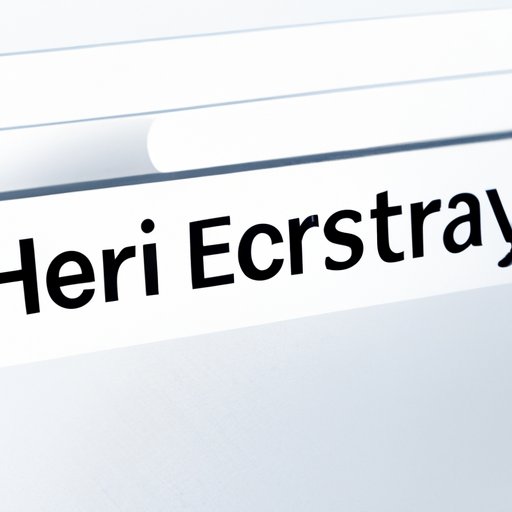I. Introduction
Have you ever noticed how your browser seems to remember everything you search or browse online? This can be a useful feature at times, but it can also be a privacy concern. Clearing your browser history ensures that your data is protected and not collected by third parties. In this article, we’ll guide you through the process of clearing browser history on popular browsers and provide different methods to suit your preferences.
II. Step-by-Step Guide
If you’re unsure how to clear browser history, don’t worry. We’ll break it down step-by-step for each browser:
Clearing browser history on Chrome
1. Open Google Chrome and click on the three dots located on the top right corner.

2. Go to History and click on History once again.

3. Click on Clear browsing data on the left panel.

4. Choose the time range you want to clear and select the items you want to delete (e.g., browsing history, cookies, cache etc.).

5. Click on Clear data and you’re done!
Clearing browser history on Firefox
1. Open Firefox and click on the three horizontal lines located on the top right corner.

2. Go to Options > Privacy & Security and scroll down to the Cookies and Site Data section. Click on Clear Data.

3. Choose the time range you want to clear and select the items you want to delete.

4. Click on Clear and you’re done!
Clearing browser history on Edge
1. Open Edge and click on the three dots located on the top right corner.

2. Go to History and click on Clear browsing data.

3. Choose the time range you want to clear and select the items you want to delete.

4. Click on Clear now and you’re done!
Clearing browser history on Safari
1. Open Safari and click on History.

2. Select Clear History and choose the time range you want to clear.

3. Click on Clear History and you’re done!
Clearing browser history on Internet Explorer
1. Open Internet Explorer and click on the gear icon located on the top right corner.

2. Go to Safety > Delete browsing history.

3. Choose the items you want to delete and click on Delete.

4. You’re done!
III. Video Tutorial
For those who prefer a visual reference, we recommend this video tutorial on clearing browser history:
This video covers how to clear browser history on Google Chrome, Firefox, and Safari. Use it as a reference or follow along to make the process even easier!
IV. Listicle-style Article
Here are some different methods for clearing browser history:
1. Using keyboard shortcuts
Most browsers have a keyboard shortcut to quickly clear the cache and browsing history. The shortcut varies depending on the browser and operating system, but commonly it’s Ctrl+Shift+Delete for Windows and Command+Shift+Delete for Mac.
2. Using the browser’s menu
All browsers have the option to clear cache and browsing history from the menu. Open the menu and look for options such as “History”, “Settings”, or “Preferences”, then click on “Clear Browsing Data”.
3. Using third-party software
There are many third-party programs designed to clean up your computer and browser data. CCleaner, for example, is a popular choice that allows users to clear browsing history and cache, as well as other temporary files and cookies.
V. Explainer Article
Why should you clear browser history on a regular basis?
Firstly, clearing browser history can improve your browser’s performance. As you browse the web, data accumulates on your computer, which can slow it down. Clearing your browser history will free up resources and speed up your computer.
Secondly, clearing browser history regularly is important for privacy reasons. The information stored in your browser history can be used to determine targeted advertising and track your online activity. Clearing it ensures that your browsing activity remains private and secure.
Finally, clearing browser history reduces the risk of data breaches and identity theft. Old passwords, cookies, and other login details can be accessed by malicious actors if left unattended.
VI. Comparison Article
What are the most efficient ways to clear browser history?
Clearing cache and browsing history is a relatively simple process, but some methods are more efficient than others. Here’s a comparison of the features and benefits of different methods:
1. Keyboard shortcuts
Pros: Quick and easy to use
Cons: Only deletes cache and browsing history for the current session
2. Using the browser’s menu
Pros: Allows you to choose which data to delete
Cons: Can be time-consuming
3. Using third-party software
Pros: Provides more advanced cleaning options and automatic scheduling
Cons: Some programs require payment for full features
VII. Infographic
For a visual representation of the steps involved in clearing browser history, check out this infographic:

This infographic showcases how to clear your browser history on different browsers, as well as comparing the options you have.
VIII. Conclusion
Now that you’ve learned how to clear browser history on several popular browsers, you can choose the method that suits you best. Remember, clearing your browser history is important for privacy, security, and performance reasons.
Don’t be afraid to try different methods and compare which works the best for you. Remember, each browser works differently, so it’s best to use a combination of methods to ensure your browser history is fully cleared.
